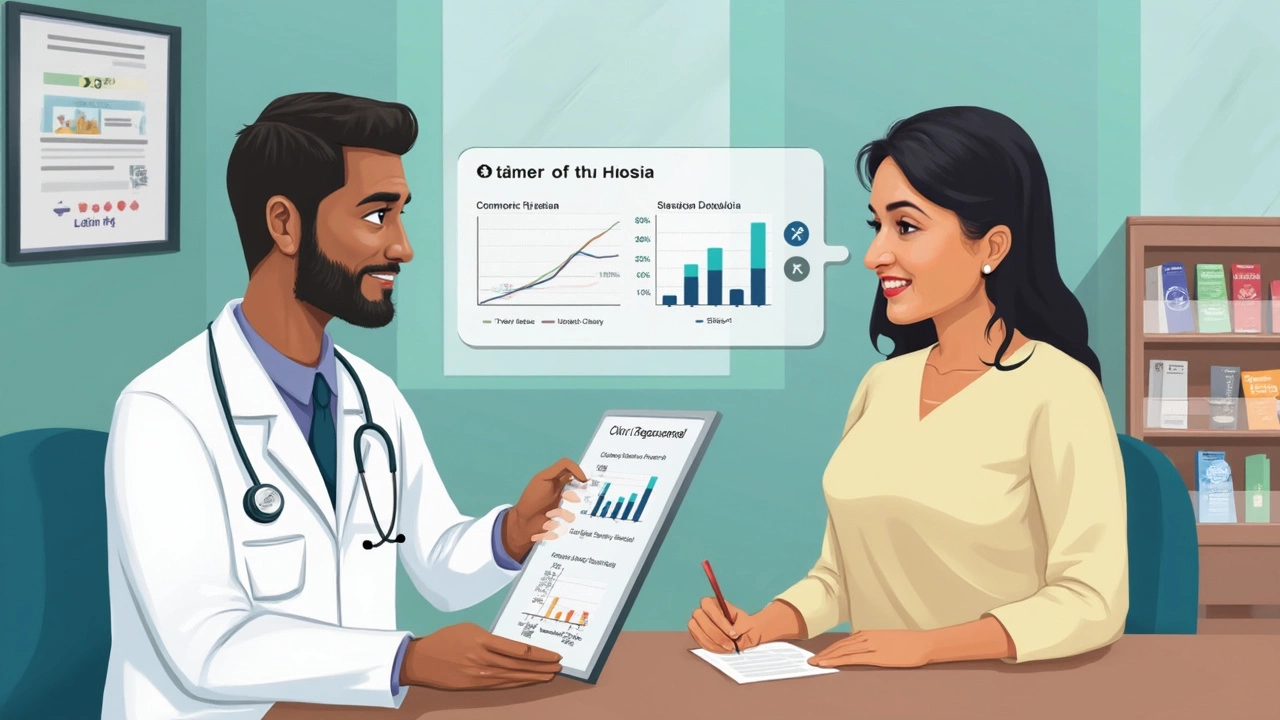Zepbound and Ozempic keep popping up everywhere—doctor's offices, Instagram ads, even dinner table gossip. It's no wonder: people are scrambling for real answers about which one actually works better, especially for weight loss and diabetes treatment. If you’re thinking about getting one of these meds from an online pharmacy, getting your facts straight is more than just smart—it can save you money, time, and maybe your health.
Most folks just want honest info: Which is stronger? Which has fewer side effects? Is one cheaper online? Right out of the gate, here’s something nobody tells you—these drugs aren’t the same, even though people say so. They target your body in their own ways and their results can be pretty different.
It’s easy to get lost in medical jargon or influencer hype. So let’s skip the buzzwords and break down what matters: the differences, what you can expect, and how to make the safest choice (especially if you’re buying from an online pharmacy).
- Quick Rundown: Zepbound vs. Ozempic
- How Each Drug Actually Works
- Results You Can Expect
- Side Effects and Safety
- Tips for Buying Online Safely
- What’s the Best Pick For You?
Quick Rundown: Zepbound vs. Ozempic
First things first, these two meds both get prescribed for adults who want to control blood sugar or lose weight—but they’re not twins. Ozempic (semaglutide) hit the market earlier and quickly got famous for helping people drop pounds, even if it was originally made for type 2 diabetes. Zepbound (tirzepatide), though, is the new kid on the block, and it comes with a lot of buzz because it tackles weight and blood sugar with a fresh approach.
Each drug works by mimicking (or boosting) the body's gut hormones. Ozempic goes after a hormone called GLP-1. Zepbound doubles up—it targets both GLP-1 and GIP, which makes it slightly more complex but possibly more potent for folks struggling with weight.
A head-to-head comparison makes it clearer:
| Ozempic | Zepbound | |
|---|---|---|
| Main Ingredient | Semaglutide | Tirzepatide |
| Launched | 2017 | 2023 |
| Weight Loss (avg, 6-12 months)* | ~12% body weight | Up to 21% body weight |
| FDA Approval | Type 2 Diabetes, Weight Loss (Wegovy version) | Type 2 Diabetes, Weight Loss |
| How Often Taken | Once weekly | Once weekly |
| How It Works | GLP-1 receptor agonist | GLP-1 & GIP receptor agonist |
*Data from clinical studies published in NEJM and JAMA, 2022–2023.
If you compare speed and depth of weight loss, Zepbound seems to edge out Ozempic for many users. But Ozempic is tried-and-true, has a longer track record, and has a big fan base. Both come as weekly shots and need a prescription.
"Zepbound's dual-action effect could represent a real game-changer for those who haven't responded as well to single-hormone therapies." – Dr. Amy Rothberg, Endocrinologist, University of Michigan Health
Quick tip: Insurance coverage, not just science, can be the deciding factor for a lot of people. Depending on your plan, one might be way more affordable than the other. And if you’re buying online, only trust pharmacies that require legit prescriptions—never buy off sketchy websites or social media.
How Each Drug Actually Works
Most people just want to know: how do Zepbound and Ozempic actually help you lose weight or bring down your blood sugar? Both are prescription shots, but what’s going on inside your body is pretty different once you inject them.
Ozempic (semaglutide) is a GLP-1 receptor agonist. That’s just a fancy way to say it copies a hormone your gut already makes, called GLP-1. When you use Ozempic, it tells your pancreas to spit out more insulin when you eat, and it slows down your stomach so you stay full longer. Less hunger means fewer snacks and smaller meals, which leads to weight loss for many folks. Plus, it drops blood sugar by a pretty solid margin—about 1 to 1.5 percentage points on your A1c (a key diabetes marker).
Zepbound (tirzepatide), on the other hand, goes even further. It works on two gut hormone pathways: it hits GLP-1 receptors just like Ozempic, but also targets something called GIP. Adding that second action can mean even more appetite control and better results for some people. In clinical trials, folks on Zepbound lost more weight, on average, than those on Ozempic. Some diabetes numbers look better too, but results can vary depending on your starting point and habits.
| Drug | Main Ingredient | How It Works | Average A1c Drop | Average Weight Loss (1yr) |
|---|---|---|---|---|
| Zepbound | Tirzepatide | GLP-1 + GIP dual agonist | 2.0% or more | 15-20% |
| Ozempic | Semaglutide | GLP-1 receptor agonist | 1.0-1.5% | 10-15% |
Here’s the quick version for everyday life: Ozempic mostly works through that one, tried-and-true hormone pathway, while Zepbound goes the extra mile by hitting a second target. That usually means you might see more dramatic changes on the scale—or on your A1c blood test—with Zepbound.
Of course, no shot is a magic pill. How well these meds work can shift depending on what you eat, how active you are, and what your doctor thinks is safe. But, if you’re chasing bigger results or your doctor says you need something stronger, that’s why Zepbound is suddenly getting so much attention from people and online pharmacies alike.
Results You Can Expect
If you’re deciding between Zepbound and Ozempic, you probably want to know which one is going to get you the results you want, whether that’s losing weight, lowering blood sugar, or both. Here’s what the most recent numbers and real-life experiences say.
Let’s start with weight loss. Zepbound (the new guy in town) is actually just tirzepatide, the active ingredient in Mounjaro, but now FDA approved for weight loss, not just diabetes. Clinical studies showed that people using Zepbound lost up to 22.5% of their body weight over 72 weeks. That’s huge—one of the best results ever seen in a weight loss drug.
Ozempic works well too, but the numbers are a bit lower. Users typically lose about 10-15% of their body weight in the same time frame. Both drugs make you feel full sooner and knock down your hunger, so you naturally eat less. But Zepbound seems to send that effect into overdrive for a lot of folks.
How about blood sugar? Both drugs do the job for people with type 2 diabetes. Ozempic lowers A1C (that’s your average blood sugar over a few months) by about 1.4%. Zepbound’s average drop is closer to 2%—a real boost, especially for people struggling to get control even with other meds.
Here’s a quick look to compare:
| Medication | Avg. Weight Loss (%) | A1C Reduction (%) | FDA Approval |
|---|---|---|---|
| Zepbound | Up to 22.5 | Up to 2.0 | Weight loss & Diabetes |
| Ozempic | 10-15 | 1.4-1.5 | Diabetes (off-label: weight loss) |
Some tips if you want to see the best results:
- Stick with the medication for at least six months to get a clear picture of what it can do for you.
- Balanced eating and moving more always boost your results. These medications work way better when paired with changes to your habits.
- Don’t freak out if you don’t drop pounds right away. Most people gradually see the biggest changes over three to six months.
- If you stall out, talk to your doctor. Sometimes bumping up the dose (if your body handles it) can get things moving again.
Bottom line: Zepbound usually wins on pure weight loss. Either way, both have helped real people turn the tide on weight and diabetes after years of struggle. Use them smartly and you’ll maximize your shot at real change with Zepbound or Ozempic.

Side Effects and Safety
No one loves side effects, but knowing what to expect from Zepbound and Ozempic can save you from rude surprises. Let’s compare what actually happens to real people on these meds, using numbers and real talk—not just the list from a drug label.
Both Zepbound and Ozempic work by affecting hormones that control blood sugar and appetite. That means the biggest complaints are usually stomach-related. We’re talking nausea, throwing up, diarrhea, constipation, and sometimes just a nagging bellyache. Some folks also deal with headaches or fatigue, especially at the start.
| Side Effect | Zepbound (Tirzepatide) % | Ozempic (Semaglutide) % |
|---|---|---|
| Nausea | 18-24% | 14-20% |
| Vomiting | 6-9% | 5-8% |
| Diarrhea | 12-18% | 8-16% |
| Constipation | 10-14% | 9-14% |
| Fatigue | 4-6% | up to 5% |
Not everyone will deal with these, but odds are you'll notice at least one, especially in the first month. Now, in rare cases, both meds can cause something more serious like pancreatitis (a painful swelling of the pancreas). That’s the emergency stuff, with sudden stomach pain that won’t go away. There’s also mention of risks like thyroid C-cell tumors in animal testing—especially with Zepbound and other meds in its class, though no human cases so far.
Doctors stay pretty honest about this. As Dr. Michelle Seger said after a large trial last year,
"The main thing patients care about is how miserable they’ll feel week to week—nausea is common, but most people adapt after the first couple doses."
People with a history of pancreatitis, severe kidney disease, or thyroid cancer in the family should mention that before starting either of these meds. If you ever notice intense pain in your abdomen, or you’re throwing up nonstop, it’s time to call a doctor—don’t push through it.
- Start slow. Most providers recommend starting on the lowest dose and moving up only if you’re handling side effects.
- If you feel queasy, light meals (think crackers, soups, or yogurt) are your friend. Skip greasy or super sweet foods.
- If ordering online, always double-check your source. Fake meds skip the safety rules and are a real risk.
If you’re shopping for these on an online pharmacy, make sure you can reach a real pharmacist for support. Some pharmacies now offer virtual check-ins to help manage side effects, which can be a lifesaver if things get rough.
Tips for Buying Online Safely
Ordering meds like Zepbound or Ozempic from an online pharmacy sounds easy, but there are some real risks most people don’t think about until something goes wrong. With all the scams out there, you have to be sharp. According to the National Association of Boards of Pharmacy (NABP), around 95% of online pharmacies operate illegally or don’t follow basic safety standards. That’s a pretty scary number.
Let’s cut through the clutter. If you want to make sure you get the real thing and not something sketchy, follow these steps:
- Check for Certification: Only shop from sites that are licensed and have credentials from trusted regulators like LegitScript or NABP’s VIPPS program. This stamp means they meet safety standards.
- Require a Prescription: Any legit pharmacy will ask for a script from your doctor. If a site promises Zepbound or Ozempic without one, run. That’s a huge red flag.
- Look for Contact Info: Real pharmacies show a physical address and actual phone numbers. Try calling them to check if a real person picks up.
- Read Their Privacy Policy: Your medical info is sensitive, so make sure their privacy policy protects you (not just a generic legal statement).
- Compare Prices—But Don’t Fall for Deals That Seem Too Good: Counterfeiters love selling fake meds for dirt cheap. Double-check against prices on well-known pharmacy platforms before you buy.
- Check the Packaging: When the order arrives, the box and labels should look like the official product from the manufacturer. No misspellings, no weird design changes.
You might wonder how big the problem really is. Here’s a quick breakdown:
| Percentage | Fact |
|---|---|
| 95% | of online pharmacies don’t follow safety laws (NABP, 2024) |
| 1 in 4 | people have received fake or substandard meds when shopping online (WHO, 2023) |
| 100% | of legit pharmacies require a valid prescription |
If you’re nervous or new to ordering meds online, talk with your doctor or pharmacist before you start. Sometimes they know safe online sources or warning signs to watch for. Remember, saving a few bucks isn’t worth it if the meds don’t work—or worse, mess up your health.
What’s the Best Pick For You?
This is what everyone really wants to know: which one makes more sense for you, Zepbound or Ozempic? The answer depends on your goals, your health, and how you feel about possible side effects and costs. Let's break it down with clear facts.
If weight loss is your main goal, studies in 2024 showed Zepbound users losing up to 22% of their body weight over 72 weeks, which is more than what most people see with Ozempic (usually around 15% in the same time frame). That looks impressive if you want real changes on the scale.
But if you have type 2 diabetes and your doctor cares most about your blood sugar, Ozempic has a longer track record. It lowers A1C (a key diabetes marker) by about 1.4% on average—good enough that a lot of doctors trust it as their first pick for diabetes.
Side effects? They overlap a lot, but Zepbound can be a little rougher at first. Nausea and vomiting come up more often, especially during the early weeks. Most side effects for both Zepbound and Ozempic mellow out with time, but don’t ignore them if they get intense.
Online, the prices can be all over the place. Here’s an idea of what you might expect if you’re paying cash (without insurance):
| Medication | Average Monthly Cost (USD) | Typical Dosage |
|---|---|---|
| Zepbound | $900–$1,200 | Up to 15 mg weekly |
| Ozempic | $800–$1,000 | Up to 2 mg weekly |
If price is what matters most, neither is exactly budget friendly, but you might find slightly cheaper Ozempic deals at big online pharmacies—or coupons you can’t get for Zepbound yet. It helps to shop around and ask for online discounts.
So, how do you choose? Here's what to keep in mind:
- If you mainly want to lose weight fast and don’t mind a little more stomach trouble early on, Zepbound's numbers are hard to beat.
- If you need strong blood sugar control—and want a med doctors already trust—Ozempic wins for most diabetes cases.
- If you have insurance that covers one but not the other—or if big rebates swing the price—go with what makes sense for your wallet.
Always, always talk it over with your doctor. These meds mean business, and you don’t want to mess with online orders unless you’re sure it’s safe and legal for you. Winning isn’t just getting results; it’s staying healthy while you do it.



